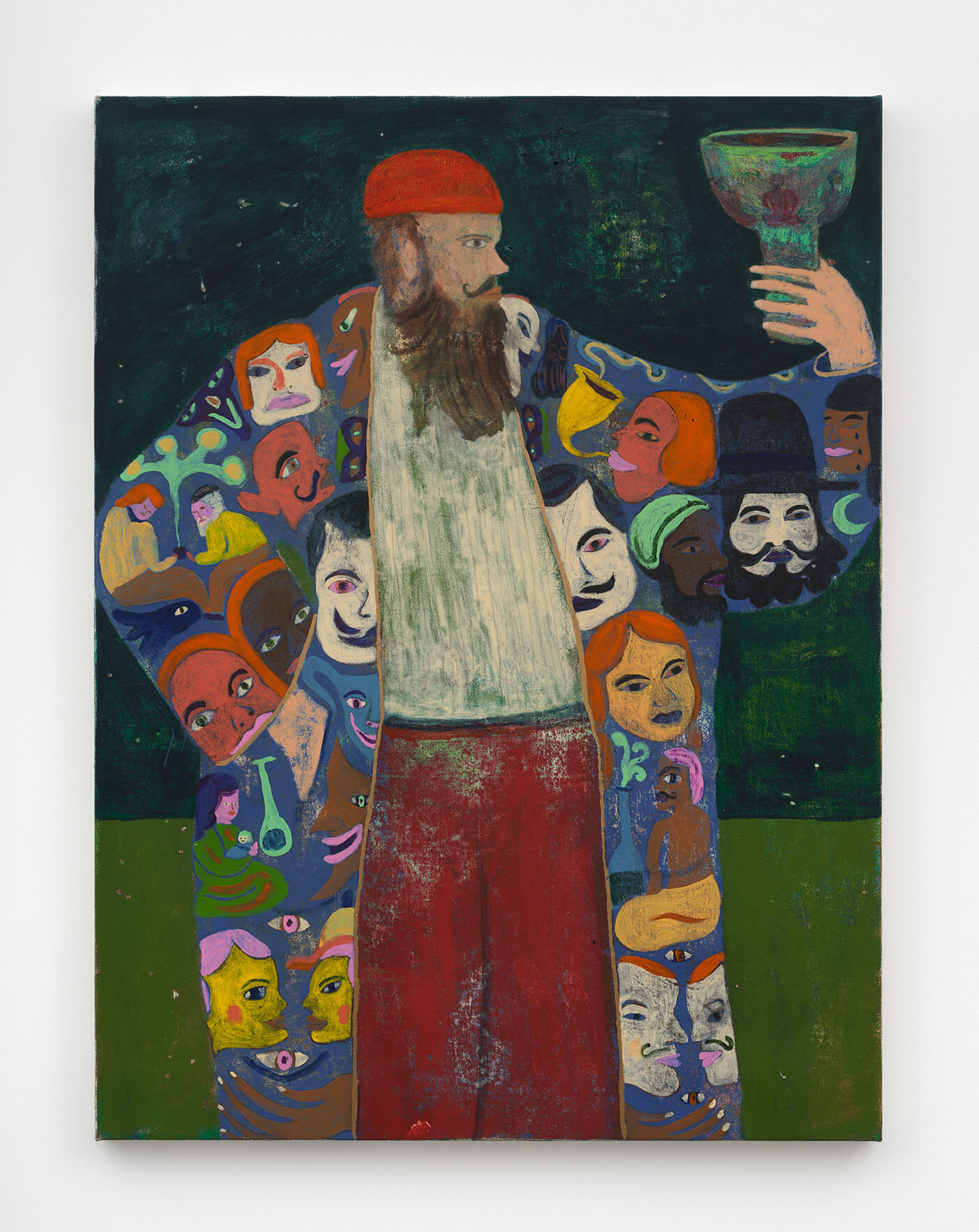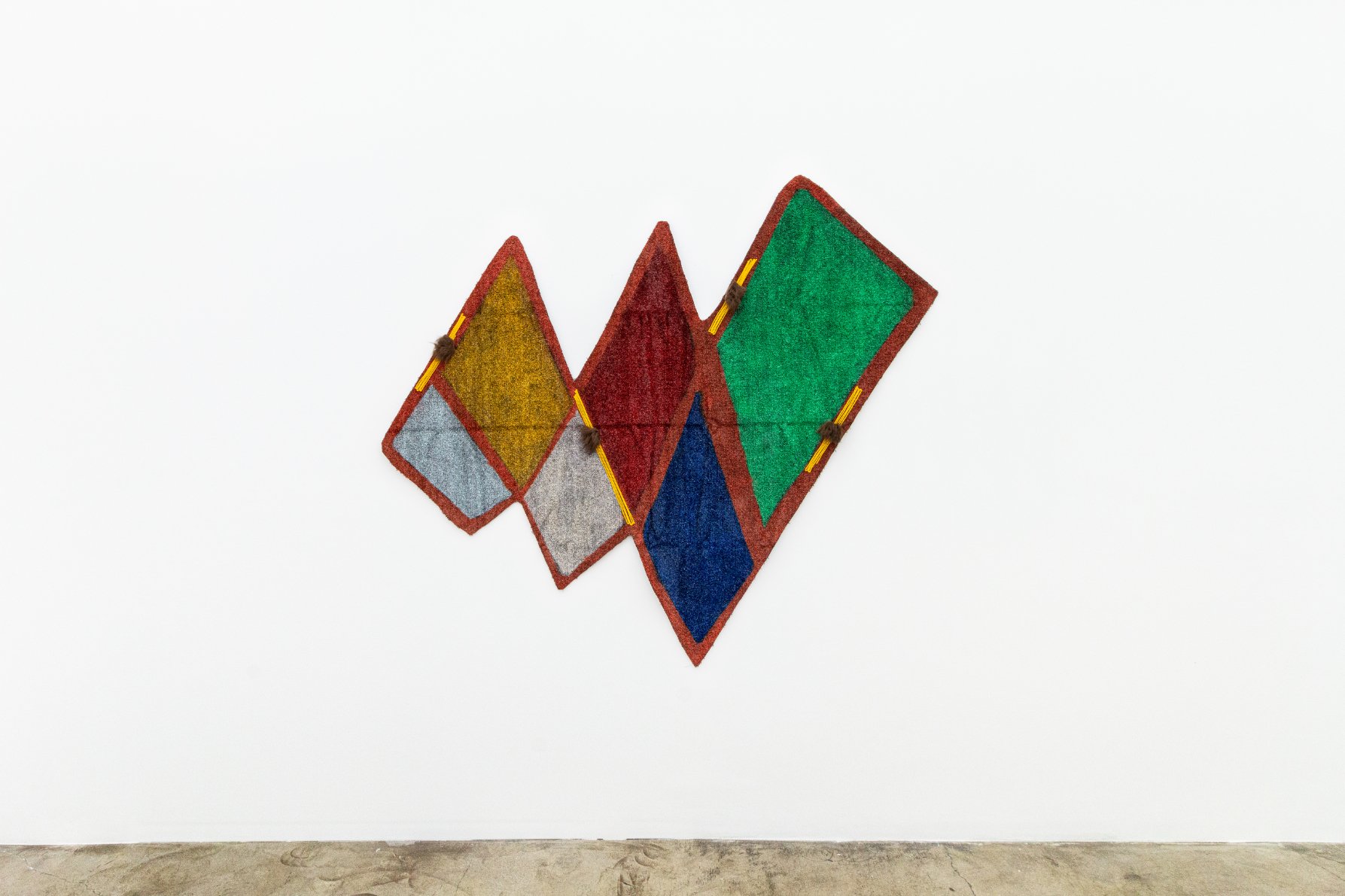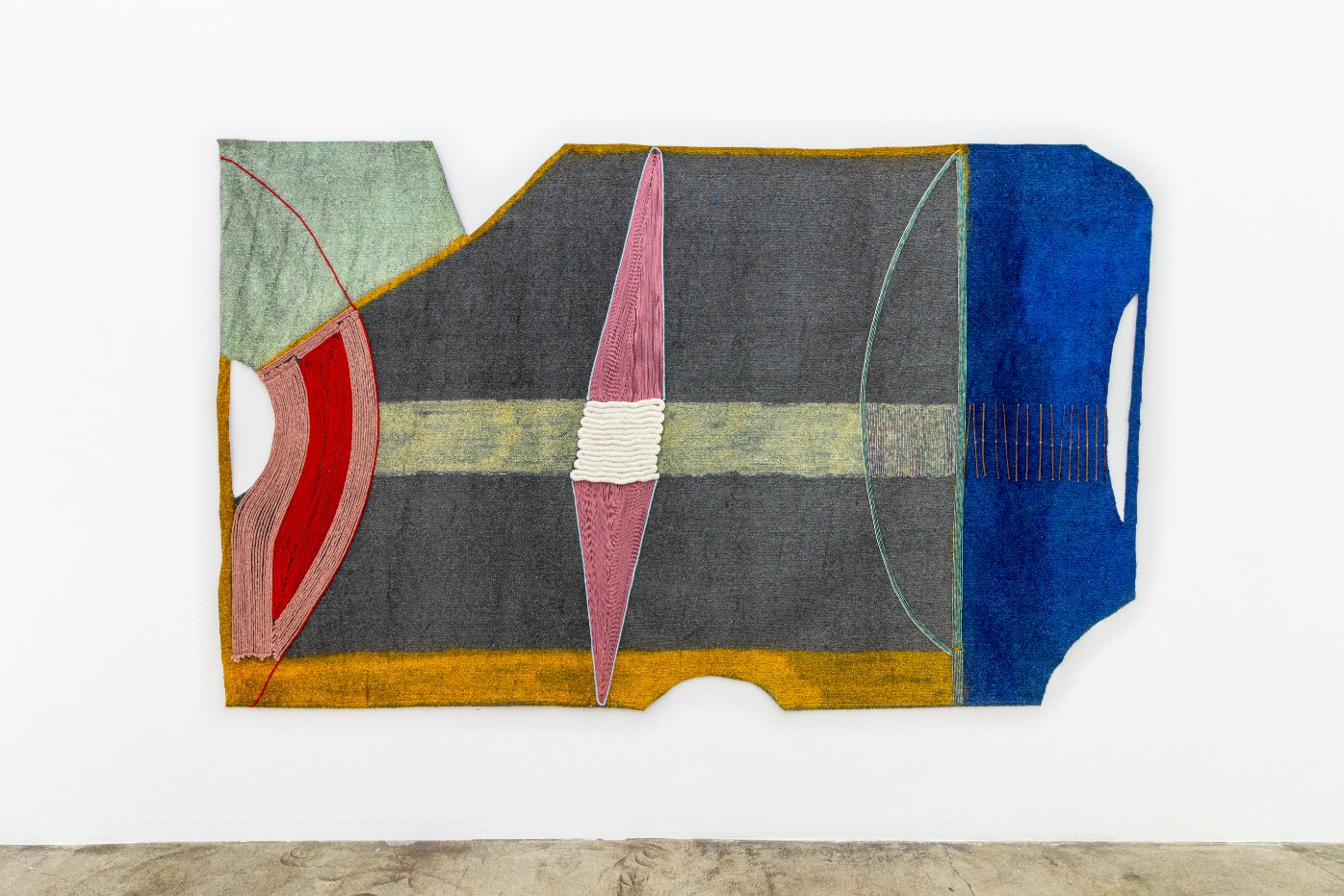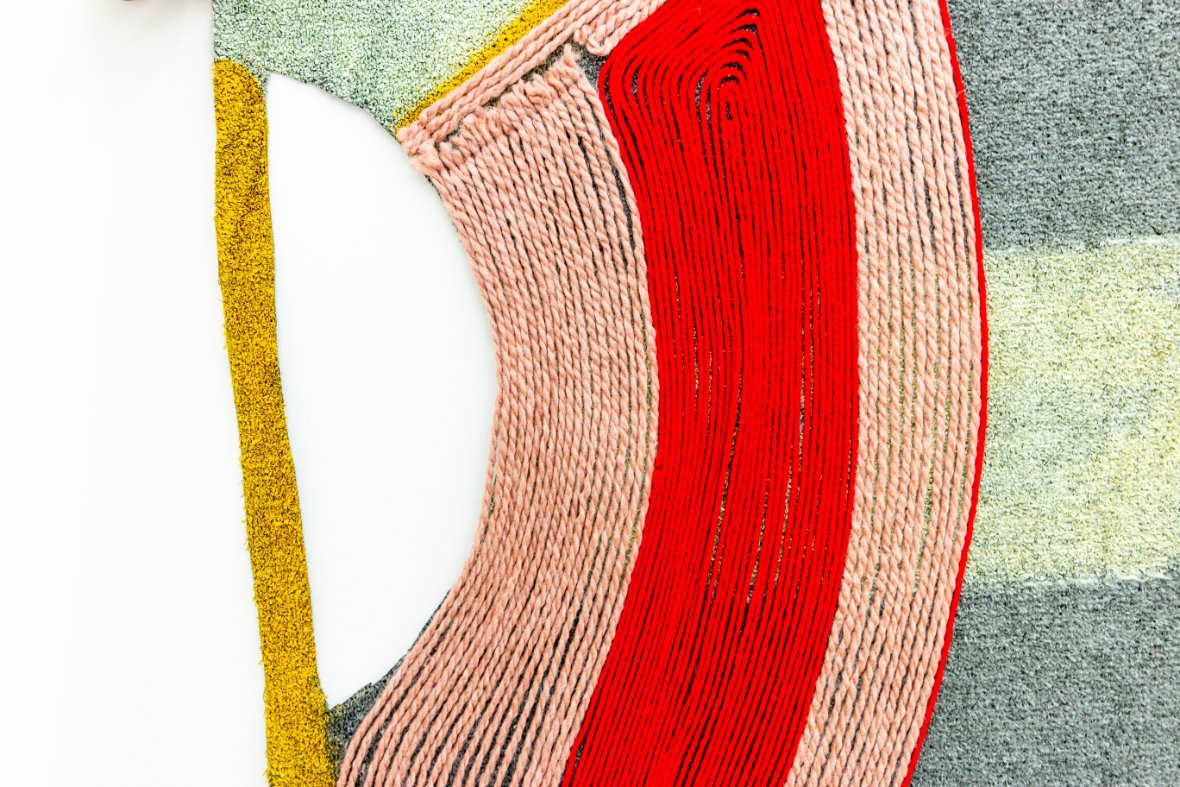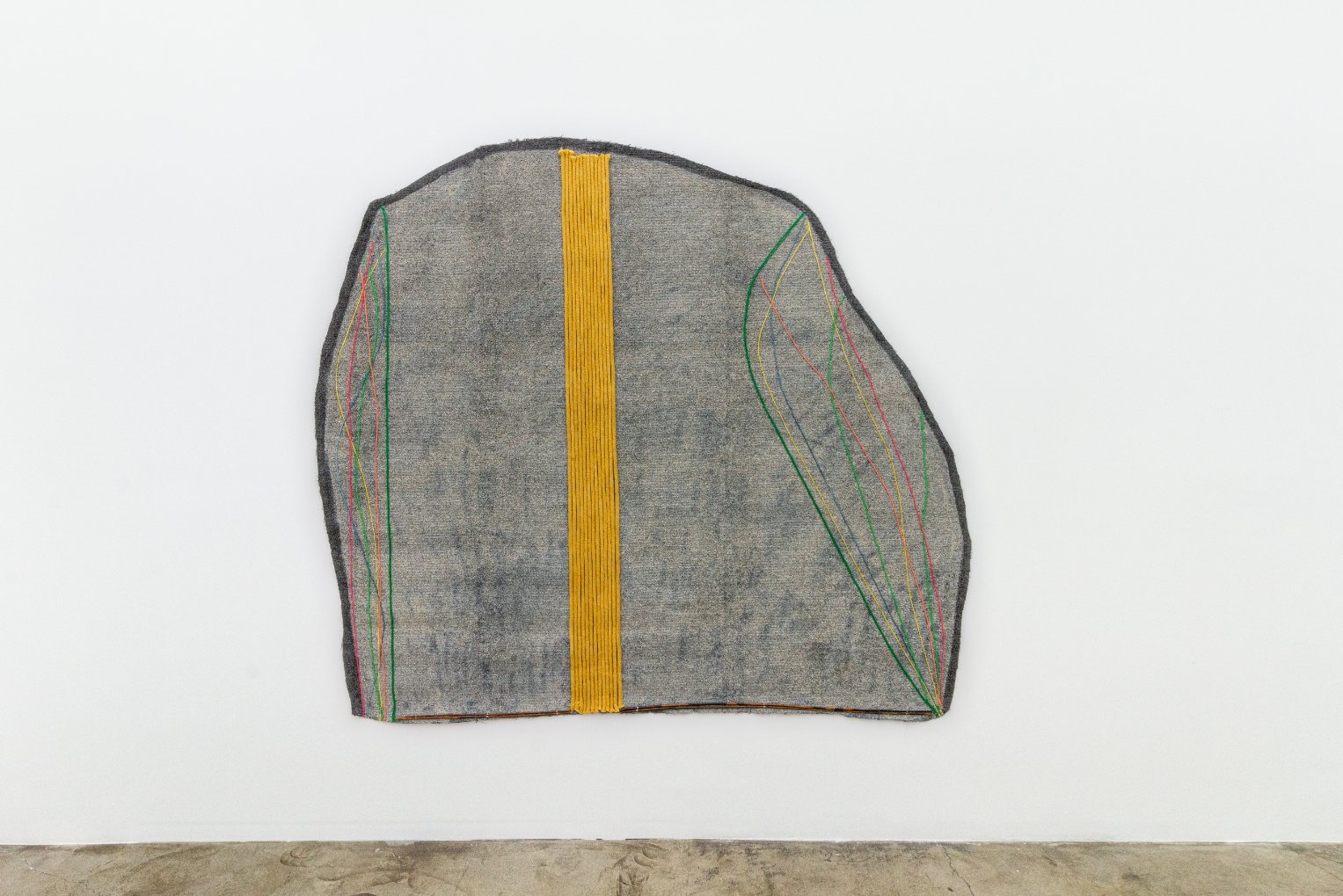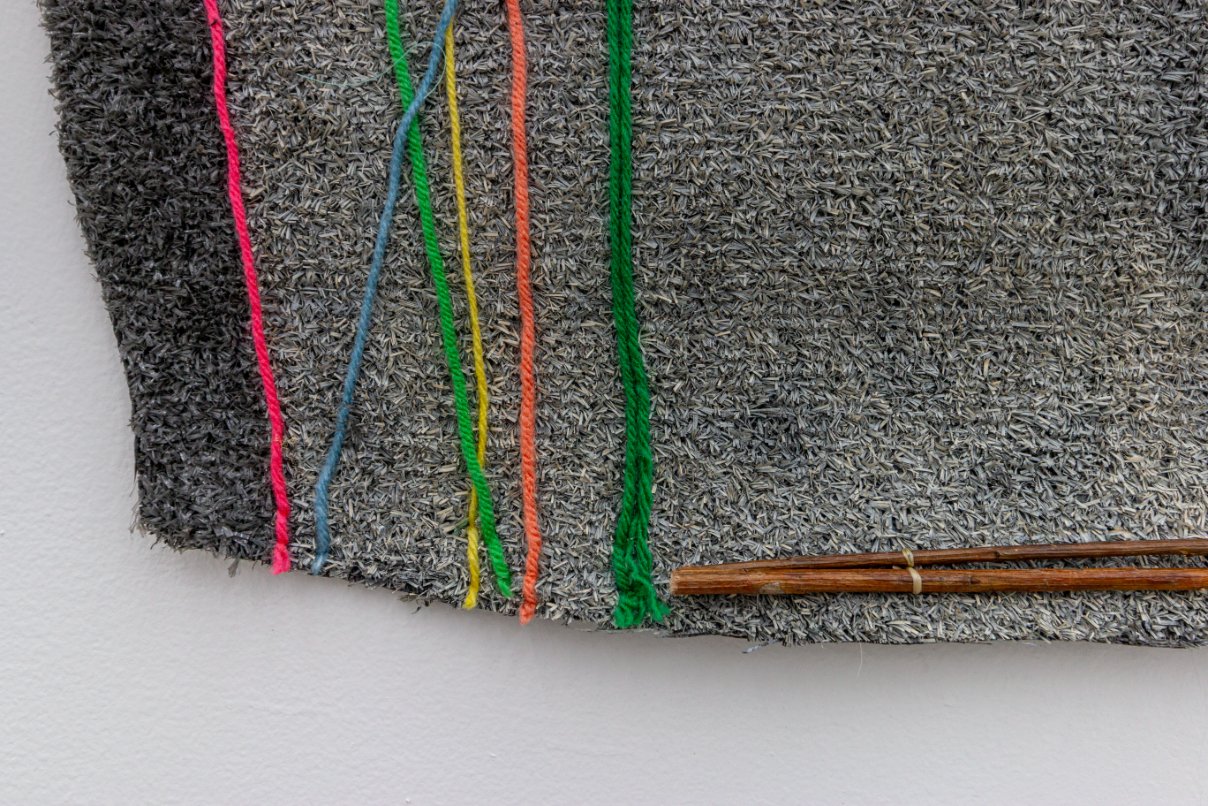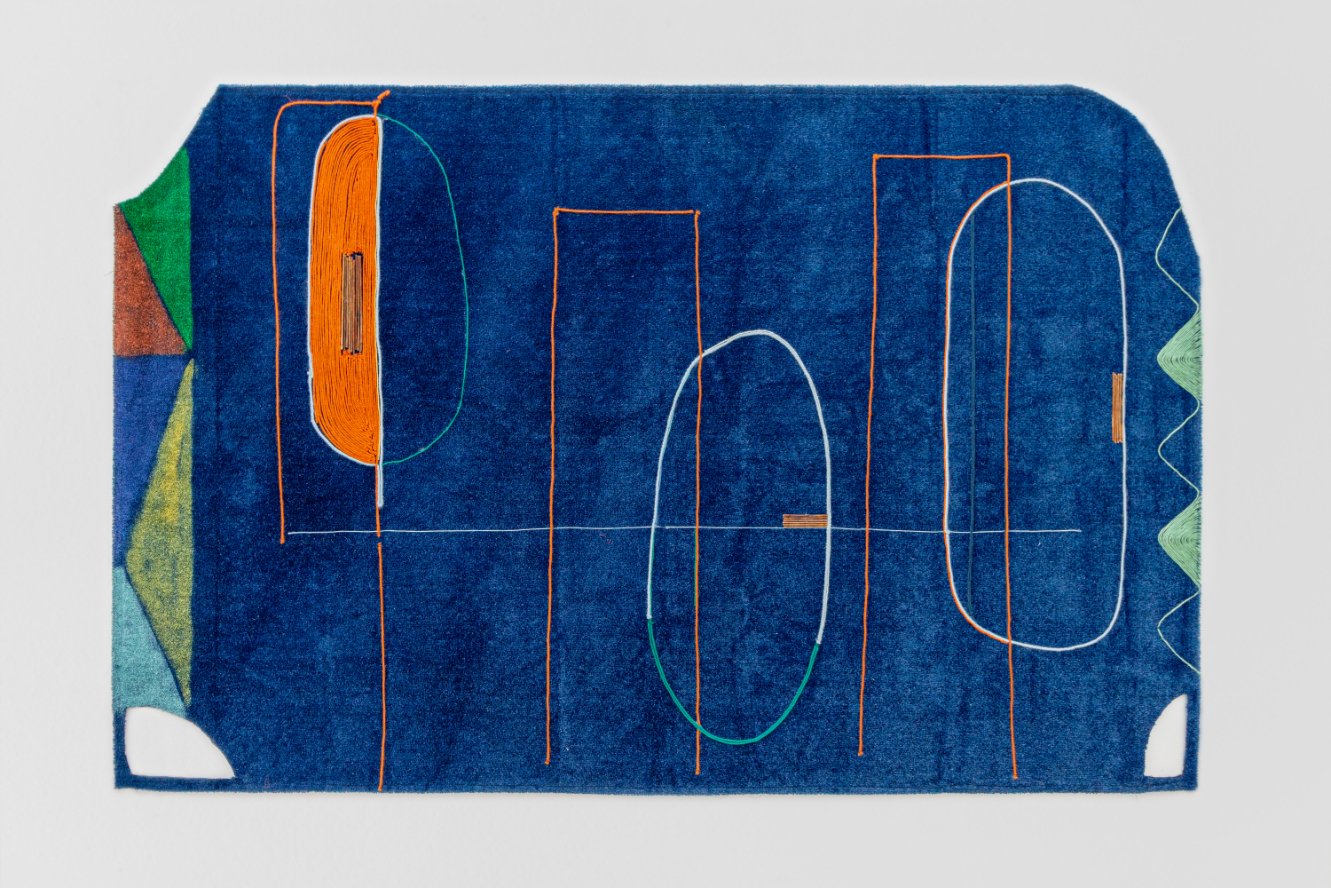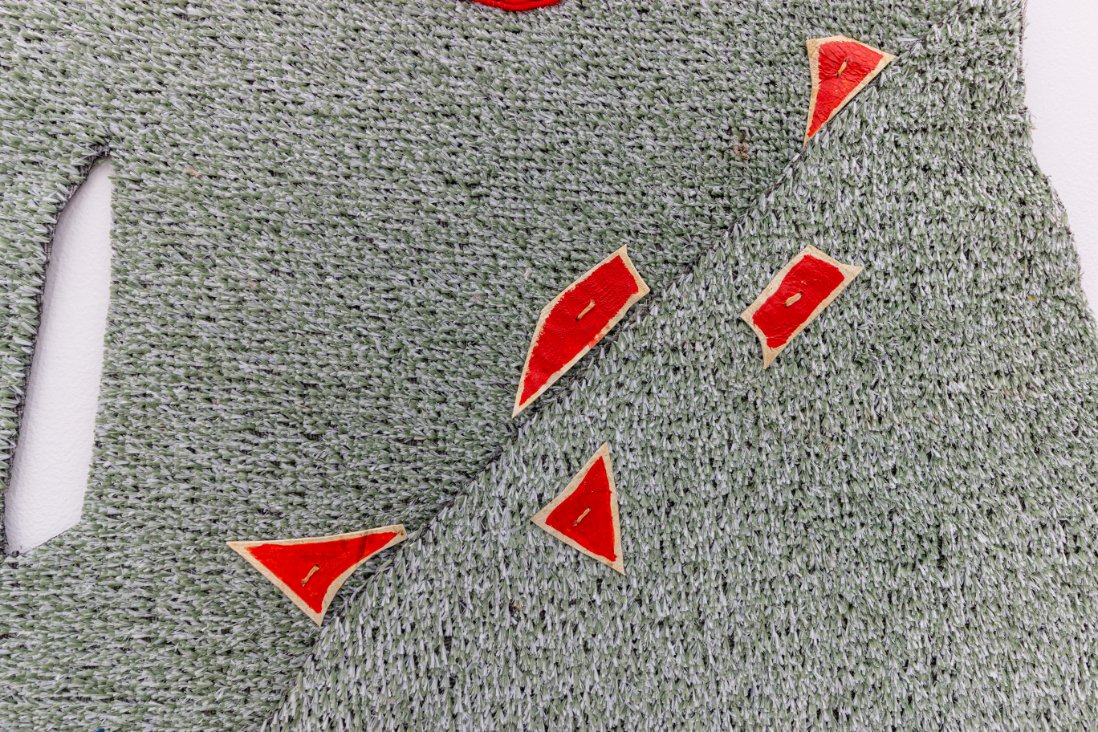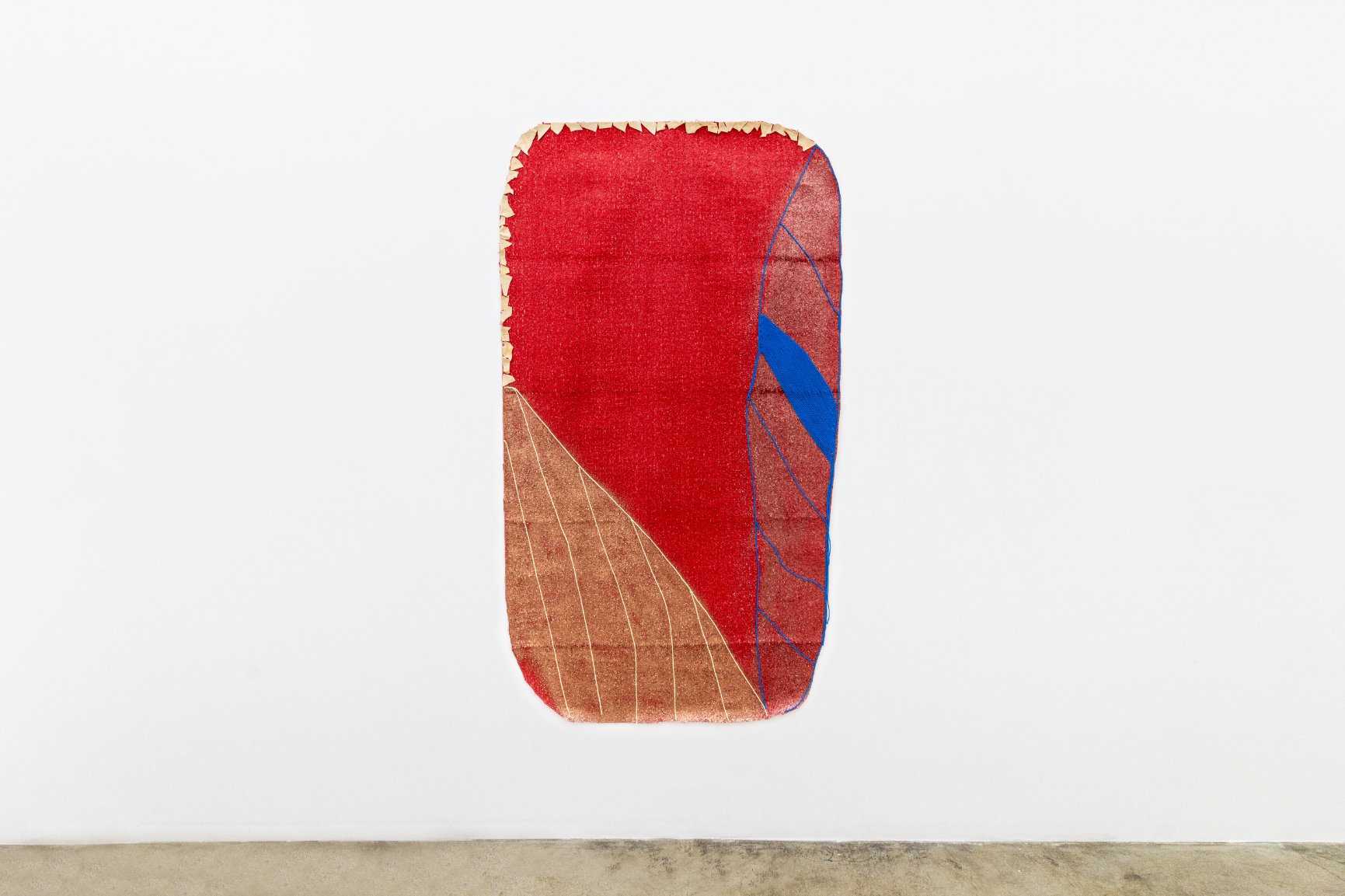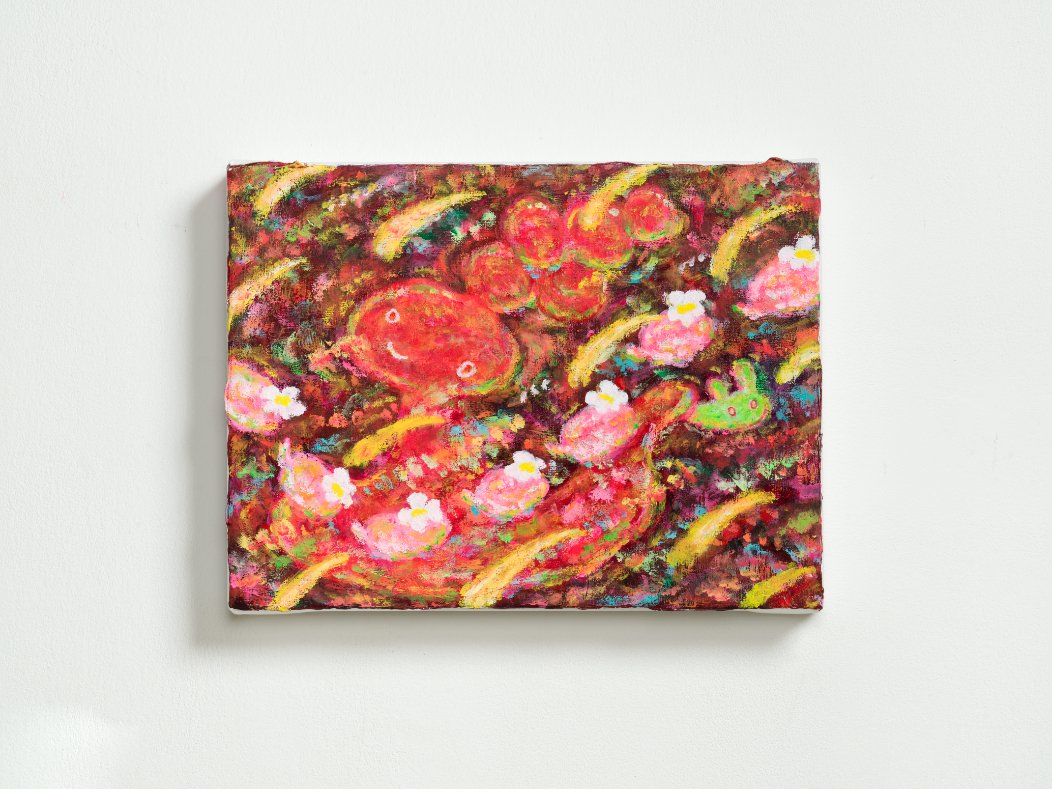Justin Williams
Major Arcana, death watching over Jade (2024)
Acrylic, oil, raw pigment and gold pigment on canvas
77.25 x 84.75 in (196.2 x 215.3 cm)
interview by Chimera Mohammadi
In Justin Williams’s newest exhibition, Synonym, at Roberts Projects, waves of stories collide and crash across timelines, pouring onto the canvas in lush and decadent palettes. Williams creates wormholes between his ancestral memories and the present day. His work carves spaces, ranging from cozy to claustrophobic, in which dead and living strangers coexist in moments of imagined connection. Williams’ world is seen through a kaleidoscope of childhood trinkets, native flora, and mythologized fauna, from goats to dogs to horses. The artist collects moments and mementos alike to collage in these quiet yet fantastical dreamscapes, mining through Westernized memories of suburban Australia and hitting rich veins of ancestral Egyptian aesthetics. Williams embraces the awkwardness of outsider life, and his work embodies the comforting realization that even outsiders create their own exiled community. To mark the occasion of Synonym, he discusses stories and people, which echo throughout his life and strangers whose moments of grief have shaped his work.
CHIMERA MOHAMMADI: I wanted to start off by asking what a day in your practice looks like.
JUSTIN WILLIAMS: I've tried to level out a lot. I got married, met [my wife] Jade, and I'm kind of trying to be normal in a weird way. It's been really productive, forcing myself to sort of start at 9:00 and work ’til dinnertime or whatever. And that might not be working – I might just sit on the couch and look at a painting and be like, “That looks ridiculous.” It's basically just get up, start making marks, and then from there, I'll kind of lose time.
MOHAMMADI: Your upcoming show at Roberts Projects, which looks gorgeous, is entitled Synonym. Is there a meaning behind that title for you?
WILLIAMS: Titles and names for paintings and things like this, it's a real collage, and an abstract process because I'm super dyslexic. So, I like words in the sense of how they sound, and it could be related to the show. It [Synonym] feels really circular. One painting might be about a weird transitional experience, or a story, or a secondhand story, or cults where I'm from, or these things. I tried to distill it into one thing, thinking that that's like what you're meant to do as an artist, but then I'd rather the painting inform what the show is. So, if one painting’s about this guy I knew growing up called Baba Desi, the Belgrave Wizard — and I love the fact that he was just this weird dude that worked at a post office, really suburban, normal, nice guy, who had a full meltdown and decided he wanted to carve sticks and be a wizard. And I'm like, What the fuck? Where did that point happen? This in-between moment. One painting would lend itself to that, and then the next painting might be a portrait of Jade and all my fears and feelings I didn’t even know I had about normality, coping with that through a painting. They're two very separate topics, and I was always like, Fuck, is it too schizophrenic or not cohesive to show altogether? But it all comes back to self-portraits. Like, Why am I interested in these things? So, it's one topic, but it's split off on a journey.
Justin Williams
The Belgrave wizard-Baba Desi (2024)
Acrylic, oil and raw pigment on canvas
48 x 36 in (121.9 x 91.4 cm)
MOHAMMADI: Do you consider yourself a figure within this sort of mythology of the ordinary that you're creating in your work? Or are you an outside spectator looking in? What's your relationship to it?
WILLIAMS: I feel like the ones that are more successful, it's like I'm a spectator. Sometimes I know the story, but I always want it to feel like this moment when something weird's happening at a park or a friend's house. It's like, you know what's going on, and you kind of walk past, but you can be drawn in, or you can not go into it, but you know you want to find out about it later. I like those ones where it's this banal jumping off point. And sometimes, when it's to do with stories, as opposed to things that I've experienced, they're really interesting. It's a lot of things through my grandma and her side through Alexandria, [Egypt] and the stories that just seem so normal, the way she says this shit. I made this painting of her, because she got bitten by a scorpion. There's two different types of scorpions. One will kill you and one won't. And she's like, “Oh, we made the nanny suck the poison out of the bite to make sure because it could have killed me or not killed me until the Bedouin doctors arrived.” And I'm like, “Fuck. You just put this poor lady's life in danger, and you got bit by a scorpion, which is crazy for me anyway.” But the way my mind is interpreting that is through a painting, and I've made that painting a couple of different times because I want to think of what my [grandma] Norma was thinking. Also, the experience of this probably 20-year-old lady that's not getting paid that well, sucking poison out of this young girl. Everyone was okay, and it's all fine, but it's this weird magical world.
MOHAMMADI: You've said that your grandparents’ migration from Egypt wasn't really discussed in your family, and it's a very prominent theme in your work. I was curious if the tension between your connection to that culture and your familial distance from that heritage has informed your work?
WILLIAMS: I've wanted to go and do residencies there [in Egypt], but you know when you listen to a song, say you're going through a gnarly breakup and there's a particular song that carries you through it, and you know that in ten years when you listen to it, you're going to think of Simon or some shit? It's precious. You won't put it on all the time. I want to be ready when I go to Egypt and spend time because I'm not a holiday painter either. You’ve got to understand, too, Australia in general, and especially where I was from, is an ancient civilization mixed with a really young culture. If you don't become a builder or a plumber, love surfing and football … it's just happy and dumb in a fucked up way. And I hated football, all that shit, so much that I really thought there was something wrong with me. And then, you mix in my mum's side, going to primary school with a fucking bowl of tabouli and some falafels, I'm like, Fuck that. Give me white bread and a sandwich so no one thinks I'm weird. My dad's side's full of Irish convicts. That’s where the name Williams comes from. And so, I was able to fit in really well with a group of normal Australian people, but secretly, I'm like, Fuck, I love art, and I want to know about Matisse. So, I think being an observer, an outsider, in these kinds of situations, is overall what I feel the work's about.
MOHAMMADI: What does it mean to be an outsider?
WILLIAMS: I think everyone is in a certain aspect of the word, but it's like, who fights? You feel more comfortable if you fit into a culture. It makes things seem right. So, if you're in between, or you're listening to what you know is actually legit to yourself, it's a weird friction. For a long time, I felt like I was pretending. Now I'm awkward and the paintings feel awkward and I'm okay with that. If you're at a dinner party or whatever, the people that are cool and boring, they won't really gravitate to the weird, overweight accountant-looking dude or whatever. But that's the guy you want to talk to. He's the best. I'm really fascinated by authenticity, even if it's wrong and misguided. You know when you've got some cool people coming over, so you're not going to put on the music that you're actually listening to? I want to put on the music that I actually listen to and be pathetic. That's the feeling that I want. And that's okay.
MOHAMMADI: How does this outsider status or culture inform the creation of the fictional communities and moments of togetherness that take center stage in your work?
WILLIAMS: It goes back to trusting in the work. It's like collage in a way. So, it might be two stories. A good example is one of the paintings, This trap I lay for you, about this guy, Neil. I used to cut up firewood for these bed and breakfast type things in this town called Sassafrass, which is a bit bougie in the hills for glamping kind of couples. Neil was the coolest looking dude. He had this big, massive beard, and this huge goat, which was kind of weird in this area. One day, I was dropping his firewood off, and he's out front, holding an Angora goat. It's this red color and it was dead. Its neck was sagging, and he's bawling out, crying. I was like, "Oh, you okay?" He was like, "Fucking dead. It's dead." The goat had eaten an old gasoline can. He’d had this goat for a really long time. I was like, “Oh, that's really sad. I'm sorry about your goat.” And he's like, “No, you don't understand. It was my late wife's goat. The goat's dead. My brother's dead.” So, I went over there thinking, I'll listen to the bullshit and whatever. But it fucking broke me because he was totally in love with this lady. The way he described it was this beautiful romance. They had an antique shop, which was why his house and backyard was just filled with shit. She died of cancer. The goat was hers because she wanted to make jumpers out of it. It was just this real sense of loss. That was the last straw, this dumb goat that he didn't even like. He hated the fucking goat. But it was a really sad, beautiful moment. I felt like I'd gone into a painting in a way, and he'd given me a gift in that sorrow too. I made that painting a lot of times. So I'll think, I'm going to make that painting from the perspective of Neil. And then aesthetically, it just comes down to something that looks better than something else. I'll have to get rid of Neil, and then another figure that’s in there might look like my dad. And then, the story is suddenly about two random stories coming together that don't mix. They don't make sense. But for me, I know exactly what's going on.
Justin Williams
This trap I lay for you (2024)
Acrylic, oil and raw pigment on canvas
76.5 x 86.75 in (194.3 x 220.3 cm)
MOHAMMADI: I was interested in the prominence of nature in your work because you're a portrait artist and people are the focus of your work. But even your indoor pieces have these little lush pockets of flora and often a dog or a horse, and I was curious about what these natural motifs represent for you.
WILLIAMS: Most of the work is from where I grew up. When people think of Australia, they'll think of beaches or desert, but where I'm from was prehistoric looking, in a way, and almost more indicative of a European forest. You've got these really old ferns. And my dad's a landscape gardener too, and he's like Google. You can be like, "What the fuck's this plant?" He'd be like, "It's a Pacificus Metallicus. It originates from South Africa and the Roman gypsies brought it in through the desert.” And all this kind of shit that you don't need to know. So, the plant-based stuff is pretty much where I'm from. And being in Santa Fe, the landscape is very different here. Sometimes I'll bring in some of that kind of stuff. Again, it's that collage type of thing. My cameras are filled with really boring things like a fence and a little path. I'll use these little things for reference, but I don't want too much information either. I like to give myself a little bit of an idea of how to do stuff and then not print them off really big and know how to fucking make it work. The shadows are all wrong. They're things that are not meant to work. It helps convey awkwardness within the work. But yeah, a lot of the plants just come from where I'm from. And growing up, too, [my grandparents], they're the first people I'd ever known that had indoor plants. I thought it was crazy. Plants inside the house! It blew my mind. I mean, now it's really normal, but that ’90s thing for Dad was potpourri and dried shit. So, these lush green things were like an art class and over the top. I fucking love it. Mum would be like, “Ah, it's disgusting. Trying to fit in.”
MOHAMMADI: What role does your ancestry play in your life? Are ancestors guides, reservoirs of material, inspirations, missing persons?
WILLIAMS: As I got older I was like, Fuck, that's pathetic. I should have been embracing this shit and finding out more. It's been a real race for me. Now [my grandma] Norma's ninety-eight. She hasn't really got long to go, and she doesn't really make that much sense anymore. So, I'm just really trying to get as much information from her, and Mum as well, but Mum's like, “No, we're Australian.” That's it. Within my family too, Mum's like, “I don't know where this art shit came from.” It's apologetic almost. But I've accepted that's what I'm doing, and they've accepted, “Okay, if we don't hear from Justin for three months, that's fine.” But I think opening that door—because I was already painting and drawing and doing a lot of things before I really wanted to know where it came from—it helps me accept that artistic side of why I'm interested in these ideas. And because art wasn't really a thing. They just would have a really beautiful ceramic dish that they used for something. It has to be over the top and lavish and beautiful. And so, I liked these little objects, like a lamp with a camel attached to it or some shit. It's tacky and pitch almost, but every object had a weird, over-the-top kind of thing. It stood out a lot more because you're in this beige, suburban, claustrophobic environment. So you can tell, Oh, fuck, that's not from here. You can't get that down at 7-Eleven. That's from somewhere else. So I think it helped me to be like, Okay, it's in my blood, and I really want to make things.
MOHAMMADI: I wanted to dig into the phrase ‘displaced timeline’ in your bio. In the press release, Synonym was “aiming to transcend sequential timelines.” Could you elaborate on the relationship to time in your work?
WILLIAMS: I think that touches on that collage aspect that I was talking about before. A good example would be, I made this painting last year. I was walking the dog to the dog park, and I had this moment. There's this red fence and there's snow everywhere. And I feel like a newborn giraffe walking in the snow. I'm also like, “Whoa, snow.” All the time. Jade's like, “Who cares? It's annoying.” But I had this moment of me walking through the snow, thinking about Oswaldo, my grandpa. He died never seeing snow. Oswaldo Died Never Seeing Snow was the title of the painting. I painted this big red fence with the snow, and then I painted my grandpa on the horse in the snow because it's like these two timelines. This guy's dead, long gone, and he would have never experienced snow because he came from Alexandria to Australia. He would have never had this human experience that I'm having right now. And the horse, because he was similar to the guy with the goat. That's why I think I really sort of meshed with that story, because he had a horse in a tiny backyard in Melbourne. He was like, "Well, fuck. I can have a horse. We could have him in Alexandria. I want to have a horse.” He'd walk his horse around. The council came in and made him get rid of it. I just like the idea of him in my timeline, the present time, walking past this thing.
Synonym is on view through March 9th at Roberts Projects LA, 442 South La Brea Avenue, Los Angeles.


